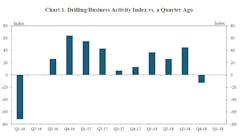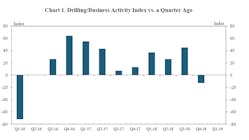The Federal Reserve Bank of Kansas City’s first-quarter Energy Survey revealed that energy activity in the Tenth District was essentially flat, but the outlook for future activity rose moderately.
Firms reported that oil prices needed to average $52/bbl for drilling to be profitable, down slightly from 6 months ago and below both current and expected prices.
“Higher oil prices in 2019 appear to have stabilized the regional energy sector following a decline in late 2018,” said Chad Wilkerson, Oklahoma City Branch executive and economist at Kansas City Fed. “Drilling is expected to be a little higher in coming months, as oil prices are expected to stay above the $52/bbl that firms report is needed, on average, to be profitable in the fields where they are active.”
The Kansas City Fed’s quarterly Tenth District Energy Survey monitors oil and gas-related firms located and headquartered in the Tenth District, with results based on total firm activity. The Tenth District encompasses the western third of Missouri; all of Kansas, Colorado, Nebraska, Oklahoma, and Wyoming; and the northern half of New Mexico.
Survey results reveal changes in several indicators of energy activity, including drilling, capital spending, and employment. All results are diffusion indexes—the percentage of firms indicating increases minus the percentage of firms indicating decreases.
Indicators
The drilling and business activity index increased from -13 to 0, indicating unchanged activity in the first quarter, following a decline in last year’s fourth quarter. Indexes for total revenues and delivery time rose, and profits moved back into positive territory. However, the employment and wages and benefits indexes dipped further, and the index for access to credit remained negative.
Most year-over-year indexes decreased moderately. The year-over-year drilling and business activity index was flat, while indexes for revenues, capital expenditures, and profits dropped. Year-over-year employment, employee hours, wages, and benefits, and access to credit indexes also dipped slightly.
Expectation indexes improved markedly, with the future drilling and business activity index jumping from -19 to 17, although this level of expectations was still lower than in 2017 and early 2018. The future revenues, capital expenditures, and profits indexes rebounded substantially as well, with positive readings. On the other hand, the future employment and access to credit indexes edged lower, and the expected wages and benefits index dipped to the lowest level since the second quarter of 2017.
The oil price expectations index increased modestly, from 29 to 34, and the natural gas price expectations index recovered substantially, increasing from -33 to 3.
Special questions
This quarter firms were asked what oil and gas prices were needed for drilling to be profitable on average across the fields in which they are active (in alternate quarters they are asked what price they need for a substantial increase in drilling).
The average oil price needed was $52/bbl, with a range $30-85/bbl. This average was down slightly from $55/bbl in third-quarter 2018, but matched the price reported in first-quarter 2018. The average gas price needed was $3.02/MMbtu, with responses ranging $1.50-5/MMbtu.
Firms were again asked what they expected oil and gas prices to be in 6 months, a year, 2 years, and 5 years. Expected oil prices increased since the last quarter and were above the average price needed to be profitable. The average expected West Texas Intermediate prices were $60/bbl, $61/bbl, $65/bbl, and $72/bbl, respectively.
However, gas price expectations decreased. The average expected Henry Hub gas prices were $2.85/MMbtu, $2.91/MMbtu, $3.05/MMbtu, and $3.18/MMbtu, respectively.
Firms also were asked about their expectations for access to pipeline capacity in the next 6-12 months. More than 62% of energy contacts expect pipeline capacity to increase either substantially or slightly in the next year. Less than 12% of firms expect pipeline capacity to decrease.
Finally, respondents were asked about drilled but uncompleted (DUC) wells. About 20% of firms indicated their number of DUC wells had increased compared with a year ago, while only around 8% expect their number of DUC wells to increase in the next 6-12 months.



